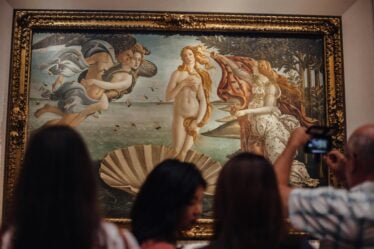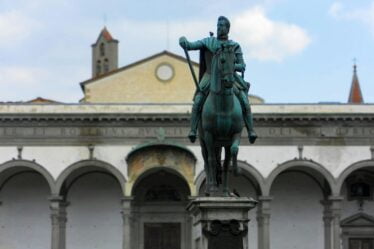

The Beautiful Scale del Monte alle Croci in San Niccolò
Located in one of the most picturesque areas of Florence, the San Niccolò district, just below the famous Piazzale Michelangelo, lies the Scale del Monte alle Croci. This historic staircase, flanked by tall cypress trees and marked by crosses along its path, offers a serene and spiritual journey up to San Miniato al Monte. A plaque on the wall at the base of the stairs contains verses from Dante’s Divine Comedy (Purg. c. XII vv. 100-105), describing the ascent to the church that overlooks Florence:
“…to go up to the mountain where the church sits that subdues the city below, where Rubaconte once shattered the bold passion…”.
The Origins of the Via Crucis: A Path of Penance
This pathway, marked with crosses, was established in 1628 by Franciscan friar Salvatore Vitale, and is known as the Via Crucis. It was created as a route for penance, symbolizing the Stations of the Cross and intended as a response to the rise of religious movements that challenged Catholicism, such as Jansenism. This movement held the belief that humans were inherently corrupt and destined to commit sin.
As pilgrims ascended the staircase, they followed a symbolic path of repentance, echoing the Catholic faith’s emphasis on reflection and penitence. Along the route, Leonardo da Porto Maurizio, a passionate Franciscan friar, would preach fiery sermons, calling the faithful to Christian penance and mercy. His emotional and fervent orations drew large crowds, inspiring many to embrace acts of faith.
The Florentine Response: Merchants and Bans
Friar Leonardo’s sermons gained widespread popularity, drawing large gatherings of Florentines to the Scale del Monte alle Croci. With the influx of people, enterprising merchants began setting up stalls along the Via Crucis to sell food, water, and various goods. However, this also attracted less savory elements, including prostitutes, who used the crowds as an opportunity to ply their trade.
In response, Grand Duke Cosimo III issued a decree to ban all commercial activities along the Via Crucis, primarily targeting these unsavory distractions from the religious significance of the site. His efforts aimed to restore the spiritual integrity of this sacred path, ensuring that it remained focused on Christian penance and devotion.



